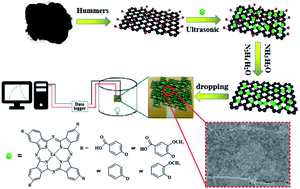A high-sensitive room temperature gas sensor based on cobalt phthalocyanines and reduced graphene oxide nanohybrids for the ppb-levels of ammonia detection†
Abstract
Highly sensitive gas sensing materials are of great importance for environmental pollution monitoring. In this study, four nanohybrid materials containing different phenoxyl substituents of cobalt phthalocyanines (tetra-β-carboxylphenoxylphthalocyanine cobalt (cpoPcCo), tetra-β-(4-carboxy-3-methoxyphenoxy)phthalocyanine cobalt (cmpoPcCo), tetra-β-phenoxylphthalocyanine cobalt (poPcCo), and tetra-β-(3-methoxyphenoxy)phthalocyanine cobalt (mpoPcCo)) and reduced graphene oxide (rGO) (RPcCo/rGO) were synthesized via non-covalent interactions as a high performance gas sensing materials for the ppb-level detection of ammonia (NH3). Various characterization techniques, including FT-IR, Raman, UV-vis, TGA, XPS and SEM, were used to confirm the structure, element information and morphology of the as-synthesized materials. The obtained materials were used in interdigital electrodes to fabricate the sensing device, and the gas sensing performance was investigated at room temperature. The obtained sensors exhibited excellent sensitivity, selectivity, good reproducibility and perfect response–concentration linearity towards NH3, which are mainly ascribed to the synergetic effects of RPcCo and rGO due to the specific surface area structure for NH3 diffusion, the abundant active sites to adsorb NH3, and excellent conductivity for efficient electron transport, particularly the effect of RPcCo. For example, the cpoPcCo/rGO-based sensor showed a higher and faster response for low concentration of NH3 (∼2.5 and 45 s for 100 ppb of NH3), a ppb level detection and superior stability over 60 days. Besides, the effect of different phenoxyl substituents of cobalt phthalocyanines on the sensing performance and the sensing mechanism for the sensitivity enhancement were discussed and confirmed by the first-principles density functional theory calculations and electrochemical impedance spectroscopy (EIS).



 Please wait while we load your content...
Please wait while we load your content...